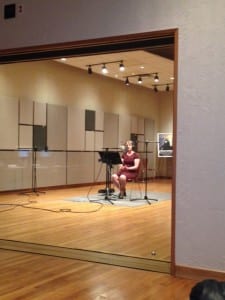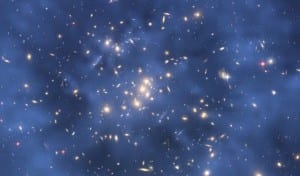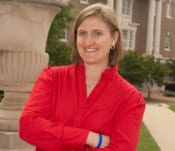Understanding what makes up dark matter and dark energy could help answer some of the biggest questions in physics

SMU physicist Jodi Cooley was a guest of Ira Flatow on National Public Radio’s Science Friday show to share in a discussion about what physicists know and don’t know about mysterious dark matter.
Dark matter is believed to make up the bulk of the matter in the universe.
Cooley, an associate professor in the SMU Department of Physics, is an experimental particle physicist and part of a scientific team searching for dark matter. She’s a member of the Cryogenic Dark Matter Search experiment.
SuperCDMS, as the experiment is called, is currently located deep in the Soudan Underground Laboratory in an abandoned mine in a national park in Minnesota.
SuperCDMS is a collaboration of 18 institutions from the U.S., Canada, and Spain.
“We go deep under the earth to shield ourselves from cosmic-ray radiation so that we can use our detector technology to ‘listen’ for the passage of dark matter through the earth,” says Cooley. “Dark matter is currently believed to be a non-luminous form of matter which makes up 85 percent of the matter in the universe.”
The next-generation of SuperCDMS is slated for construction at SNOLAB, an underground laboratory in Ontario, Canada. With SuperCDMS SNOLAB, physicists will go deeper below the surface of the earth than earlier generations of the experiment. The scientists use the earth as a shield to block out particles that resemble dark matter, making it easier to see the real thing.

The NPR Science Friday show aired March 27, 2015.
EXCERPT:
Ira Flatow, host
Becky Fogel, producer
Science Friday
Neutrons, protons, and electrons—these are the basic building blocks of matter. But this kind of matter is only a tiny fraction of the entire universe. The rest, about 95 percent, in fact, is divided between dark matter and dark energy.Understanding what makes up dark matter and dark energy could help answer some of the biggest questions in physics.
Physicists Jodi Cooley, Dan Hooper and Nobel Prize winner Steven Weinberg join Ira Flatow to discuss what we do and don’t know about this “darker” side of physics, and what we hope to learn.
FLATOW: As an experimentalist, can you perform any experiments to see what dark matter is made out of?
COOLEY: As a matter of fact we can, and there are different types of experiments that we can perform. The types of experiments that we perform fall into three different categories. Steven had already talked about the first kind, where you’re looking at dark matter particles interacting with other dark matter particles in the article that appeared yesterday.
The other way that you can look for dark matter particles is, dark matter is thought to be in the galaxy all around us, so by building experiments here on earth, we can wait and try to detect the dark matter interacting with the experiments here on earth. That’s the dark matter detection I work on. The third way you could do it is at a collider at the Large Hadron Collider, collide together ordinary matter and look for dark matter coming out.
FLATOW: Is that contemplated? They are tweaking it to come back online. Is that something they are looking for?
COOLEY: I do believe they are. They have a working group at the Large Hadron Collider, both the ATLAS and the CDMS collaborations, both have working groups with people who are looking for a missing energy signature that could be a hint of a dark matter signal.
Follow SMUResearch.com on twitter at @smuresearch.
SMU is a nationally ranked private university in Dallas founded 100 years ago. Today, SMU enrolls nearly 11,000 students who benefit from the academic opportunities and international reach of seven degree-granting schools. For more information see www.smu.edu.
SMU has an uplink facility located on campus for live TV, radio, or online interviews. To speak with an SMU expert or book an SMU guest in the studio, call SMU News & Communications at 214-768-7650.


 17 million-year-old whale fossil provides 1st exact date for East Africa’s puzzling uplift
17 million-year-old whale fossil provides 1st exact date for East Africa’s puzzling uplift SMU analysis of recent North Texas earthquake sequence reveals geologic fault, epicenters in Irving and West Dallas
SMU analysis of recent North Texas earthquake sequence reveals geologic fault, epicenters in Irving and West Dallas